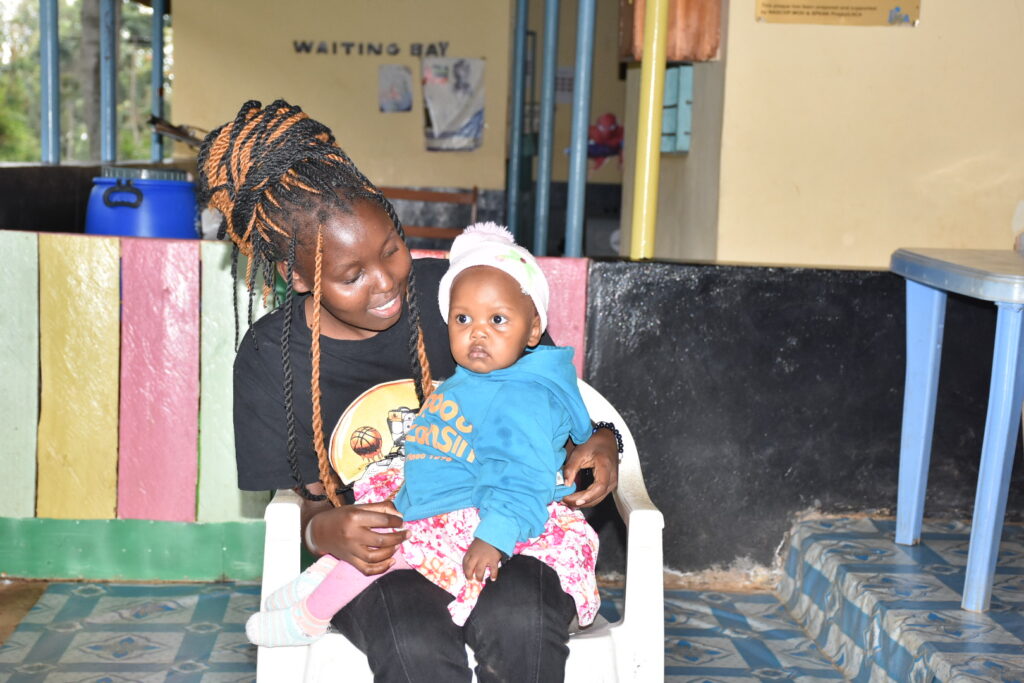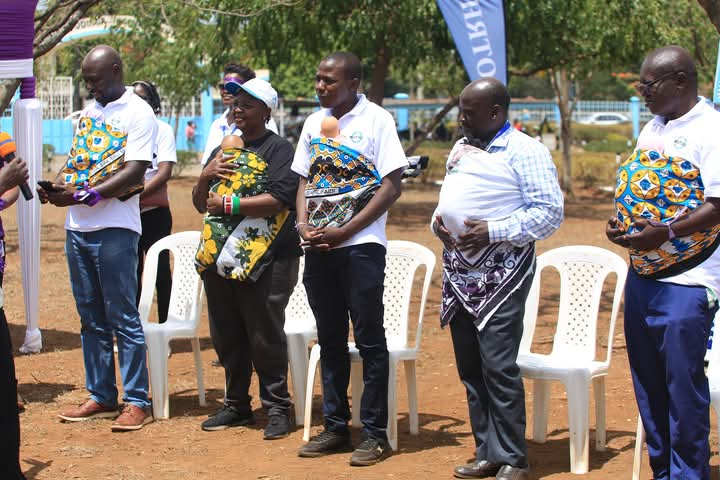Josephat Odhiambo, a father of one, tenderly holds his newly-born baby against his chest as he flashes a smile.
Happiness is written on his face as he makes playful gestures towards the infant. “I am the new father in town,” he jokes before taking another glance at his baby.
One can easily dismiss this activity as an ordinary tradition of a new father bonding with his baby. However, Odhiambo’s exercise is different and is rapidly gaining traction among parents with preterm babies.
‘My baby was born at 33 weeks instead of 40 weeks, and we have been taking care of him through Kangaroo’-joseph odhiambo
He is among the few fathers who have embraced kangaroo care, a phenomenon that is helping reduce neonatal deaths as a result of prematurity complications.
Kangaroo care
Kangaroo care is a recommended intervention for premature or low birth-weight infants. It involves holding the baby against your bare chest to ensure skin-to-skin contact.
While it has always been common among mothers, fathers, too, have started adopting the method to help their wives take care of their needy infants.
At the Maseno Mission Hospital, Odhiambo is among the fathers who are keen to ensure that their child gets the help they need to grow up well after being born preterm.
“My baby was born at 33 weeks instead of 40 weeks, and we have been taking care of him through Kangaroo,” he says.
He says the method has enabled him to create a strong bond with the infant and help the baby sleep for longer hours.
“The baby was born preterm and had been struggling to sleep, but doctors recommended that we adopt Kangaroo care to help him with mental development. I have been assisting the mother in holding the baby and providing that skin-to-skin contact,” says Odhiambo.
Odhiambo is not alone. Joram Owino, a widower, says he has also embraced the style of caring for his underweight baby to help her grow.
“I have developed a routine of having that skin-to-skin contact with my daughter to help her grow. She was born at 30 weeks,” he says.
According to Owino, since he adopted Kangaroo care, his daughter does not cry as much as she used to days after her birth.
Lived testimonies
Interviews with several new mothers who have also adopted Kangaroo care established that it has been a game-changer in their quest to take care of their underweight babies.
‘My baby was so tiny I thought that wrapping her around me would lead to her death, but the nurses managed to walk me through the journey and demonstrate to me how it is done, and I practiced it for a month, day and night’-faith rotich

According to Faith Rotich, 19, a second-year student at Maseno University and a young mother of a one-year-old daughter, her baby was preterm born at 6 months due to the distress she was going through.
She says she got pregnant when she was starting her life on campus and did not know how to take care of her pregnancy and the baby.
She noted that her then-boyfriend, who was also a student at the university, wanted her to get rid of the pregnancy, but she opted to keep it.
“I was depressed, and I struggled with the pregnancy. When I gave birth at six months, I did not believe my baby would survive. The baby weighed only 1 kilogram,” she says.
She stated that her baby gained weight after practicing Kangaroo despite being born with only 1kg.
“My baby was so tiny I thought that wrapping her around me would lead to her death, but the nurses managed to walk me through the journey and demonstrate to me how it is done, and I practiced it for a month, day and night,” she said.
Benefits of Father-Baby contact
According to Dancun Odhiambo, a clinician at Maseno Mission Hospital under the Department of Child Health, Kangaroo care practiced by fathers increases the bond between the father and the baby.
He said that the temperature the father gives to the baby provides warmth, regulates the baby’s heartbeat, and makes the baby progress well despite being premature.
He advised that the care must be shared among the couples as anyone, not just women, can do it.
“We try to encourage people that male involvement is more advantageous to the baby than the mothers, especially with the males with hairy chests,” he said.
He added that the Kangaroo care should be a general responsibility rather than a specified role for women as it can be hectic for them. It becomes easy when shared among the family members and improves family bonding.
Beatrice Mukunzi, a reproductive health nurse at ACK Maseno Mission Hospital and a coordinator of reproductive health services says taking care of preterm babies is a bumpy journey.
“When we were starting with the kangaroo services, we didn’t have any skills, but we said we would use the little available resources and the little knowledge we have to begin and see if we can grow because as a facility, when we continue to grow with our quality services, the patient is increasing especially in the maternity,” she said.
She added that in the event they realize that they are having babies who are born underweight, they need to be given extra care.
The nurse revealed that when they have preterm babies, they usually have to refer them to the Jaramogi Oginga Odinga Teaching and Referral Hospital (JOOTRH) and the Kisumu County Referral Hospital (KCRH), which are a few miles away. This becomes a challenge for both the clients and even for them.
“In April this year, we decided to create a room within the facility and contracted one of our partners, USAID Boresha Jamii, who offered to train our personnel on the Kangaroo services and gave us the continuous medical education (CME),” she said.
She added, “They gave us the knowledge on how to go about it and demonstrated to us how we can tie the baby, how we can take care of them in terms of feeds, and luckily enough before they could finish the training, a mother came to us with a premature labor of 29 weeks and during that time, there was an industrial action and the referral facilities were not working and we took it upon us.”
According to her, the baby weighed 900 grams at birth, and they decided to use the skills offered.
She says that since April, they have had 13 babies admitted to the Kangaroo mother care unit and only managed to refer one because the mother came from Kitale, which is far from the facility. We had to demonstrate to her how it is done.
“As a hospital, we are happy that we have grown and have established that service, and now we are not going to refer, and we are happy we have helped JOOTRH to reduce the burden of workload,” she said.
According to her, stress, infections in the mother, and gynecological issues may lead to preterm births.
She noted men’s involvement could increase during the ANC clinic and delivery. Many men may tend to walk the journey with their spouses, and only a few would be ready to help with the kangaroo care, but they encourage the men to support their wives.
USAID Boresha Jamii Project

Beatrice Oloo, a maternal and newborn expert under the USAID Boresha Jamii Project implemented by Jaramogi Oginga Odinga University of Science and Technology, says they trained nurses on Kangaroo care.
“We have been working closely with about 160 health facilities that conduct deliveries in the Western region,” she says.
According to experts, preterm births are among the leading causes of child mortality in the country. Data by the Kenya Health Information System (KHIS) reveal that in 2023, 37 percent of newborn deaths of babies aged between zero and 28 days were as a result of prematurity.
Kenya’s neonatal mortality rate is 21 deaths per 1,000 live births, accounting for 51 percent of under-five deaths.
Neonatal death is the death of a baby between zero and 28 days from birth, whereas a preterm is a baby born before the completion of 37 weeks of pregnancy.
Recently, the government launched a comprehensive training package on care for preterm babies to reduce neonatal mortality in the country. In the new plan, the government is pushing health facilities and Kenyans to adopt Kangaroo care to help preterm babies.
Other guidelines include monitoring feeding, respiratory support through continuous positive airway pressure (CPAP) machines, and provision of oxygen where needed.
Health Cabinet Secretary Deborah Barasa, Homa Bay Governor Gladys Wanga, and the Director General of Health Patrick Amoth launched the guideline at Homa Bay Kenya Medical Training College during the celebrations to observe World Prematurity Day.
“Preterm birth is a leading cause of death among children under five years. But some of these deaths can be prevented. Therefore, we need to be innovative to prevent the deaths,” Barasa said.
